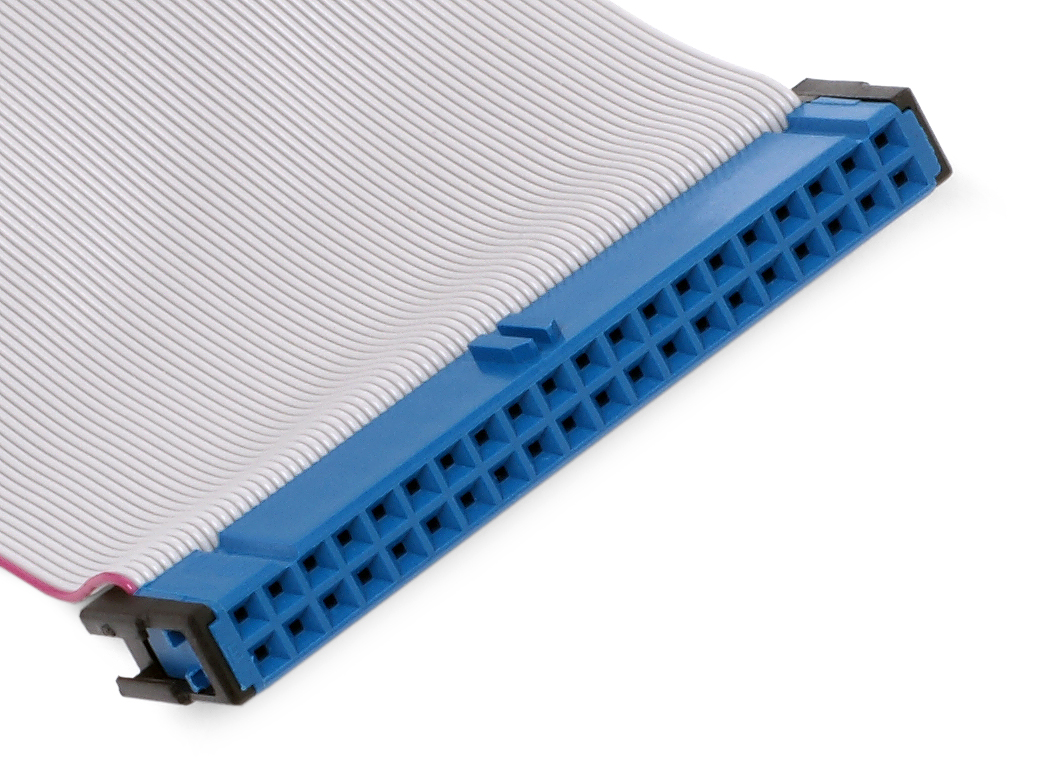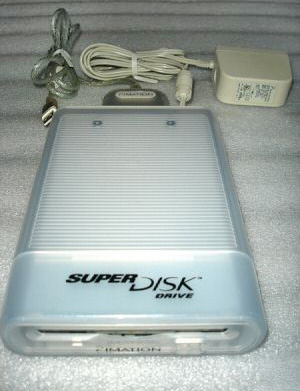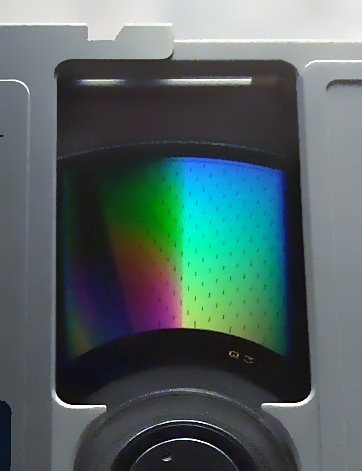|
Atapi
ATA Packet Interface (ATAPI) is a protocol that has been added to Parallel ATA and Serial ATA so that a greater variety of devices can be connected to a computer than with the ATA command set alone. It carries SCSI commands and responses through the ATA interface. ATAPI devices include CD-ROM and DVD-ROM drives, tape drives, magneto-optical drives, and large-capacity floppy drives such as the Zip drive and SuperDisk drive. Background ATA was originally designed for, and worked only with hard disks and devices that could emulate them. A group called the Small Form Factor committee (SFF) introduced ATAPI (ATA Packet Interface) ATA to be used for a variety of other devices that require functions beyond those necessary for hard disks. For example, any removable media device needs a "media eject" command, and a way for the host to determine whether the media is present, and these were not provided in the ATA protocol. The Small Form Factor committee approached this problem by defi ... [...More Info...] [...Related Items...] OR: [Wikipedia] [Google] [Baidu] |
Parallel ATA
Parallel ATA (PATA), originally , also known as IDE, is a standard interface designed for IBM PC-compatible computers. It was first developed by Western Digital and Compaq in 1986 for compatible hard drives and CD or DVD drives. The connection is used for storage devices such as hard disk drives, floppy disk drives, and optical disc drives in computers. The standard is maintained by the X3/INCITS committee. It uses the underlying (ATA) and Packet Interface (ATAPI) standards. The Parallel ATA standard is the result of a long history of incremental technical development, which began with the original AT Attachment interface, developed for use in early PC AT equipment. The ATA interface itself evolved in several stages from Western Digital's original Integrated Drive Electronics (IDE) interface. As a result, many near-synonyms for ATA/ATAPI and its previous incarnations are still in common informal use, in particular Extended IDE (EIDE) and Ultra ATA (UATA). After the intro ... [...More Info...] [...Related Items...] OR: [Wikipedia] [Google] [Baidu] |
AT Attachment
Parallel ATA (PATA), originally , also known as IDE, is a standard interface designed for IBM PC-compatible computers. It was first developed by Western Digital and Compaq in 1986 for compatible hard drives and CD or DVD drives. The connection is used for storage devices such as hard disk drives, floppy disk drives, and optical disc drives in computers. The standard is maintained by the X3/ INCITS committee. It uses the underlying (ATA) and Packet Interface (ATAPI) standards. The Parallel ATA standard is the result of a long history of incremental technical development, which began with the original AT Attachment interface, developed for use in early PC AT equipment. The ATA interface itself evolved in several stages from Western Digital's original Integrated Drive Electronics (IDE) interface. As a result, many near-synonyms for ATA/ATAPI and its previous incarnations are still in common informal use, in particular Extended IDE (EIDE) and Ultra ATA (UATA). After th ... [...More Info...] [...Related Items...] OR: [Wikipedia] [Google] [Baidu] |
SCSI
Small Computer System Interface (SCSI, ) is a set of standards for physically connecting and transferring data between computers and peripheral devices. The SCSI standards define commands, protocols, electrical, optical and logical interfaces. The SCSI standard defines command sets for specific peripheral device types; the presence of "unknown" as one of these types means that in theory it can be used as an interface to almost any device, but the standard is highly pragmatic and addressed toward commercial requirements. The initial Parallel SCSI was most commonly used for hard disk drives and tape drives, but it can connect a wide range of other devices, including scanners and CD drives, although not all controllers can handle all devices. The ancestral SCSI standard, X3.131-1986, generally referred to as SCSI-1, was published by the X3T9 technical committee of the American National Standards Institute (ANSI) in 1986. SCSI-2 was published in August 1990 as X3.T9.2/86-109 ... [...More Info...] [...Related Items...] OR: [Wikipedia] [Google] [Baidu] |
Zip Drive
The Zip drive is a removable floppy disk storage system that was introduced by Iomega in late 1994. Considered medium-to-high-capacity at the time of its release, Zip disks were originally launched with capacities of 100 MB, then 250 MB, and finally 750 MB. The format became the most popular of the superfloppy products which filled a niche in the late 1990s portable storage market. However, it was never popular enough to replace the -inch floppy disk. Zip drives fell out of favor for mass portable storage during the early 2000s as CD-RW and USB flash drives became prevalent. The Zip brand later covered internal and external CD writers known as Zip-650 or Zip-CD, despite the dissimilar technology. Overview The Zip drive is a "superfloppy" disk drive that has all of the -inch floppy drive's convenience, but with much greater capacity options and with performance that is much improved over a standard floppy drive. However, Zip disk housings are much thicker ... [...More Info...] [...Related Items...] OR: [Wikipedia] [Google] [Baidu] |
SCSI / ATA Translation
SCSI / ATA Translation (SAT) is a set of standards developed by the T10 subcommittee, defining how to communicate with ATA devices through a SCSI application layer. The standard attempts to be consistent with the SCSI architectural model, the SCSI Primary Commands, and the SCSI Block Commands standards. The standard allows for translation of SCSI read and write commands. The standard also provides the ability to control exactly what ATA operations are executed on a target device by defining two new SCSI operation codes: * ATA PASS THROUGH (Ax, 12-byte) – 28-bit ATA command without or fields * ATA PASS THROUGH (8x, 16-byte) – 28- or 48-bit ATA command without or fields History The first SAT standard was finalized in 2007 and published as ANSI INCITS 431–2007. It was succeeded by SAT-2 published as INCITS 465 in 2009, and SAT-3, which was finalized by T10 and is expected to be published as INCITS 517 in 2014. SAT-4 is in development. SAT has also been adopte ... [...More Info...] [...Related Items...] OR: [Wikipedia] [Google] [Baidu] |
Serial ATA
SATA (Serial AT Attachment) is a computer bus interface that connects host bus adapters to mass storage devices such as hard disk drives, optical drives, and solid-state drives. Serial ATA succeeded the earlier Parallel ATA (PATA) standard to become the predominant interface for storage devices. Serial ATA industry compatibility specifications originate from the Serial ATA International Organization (SATA-IO) which are then promulgated by the INCITS Technical Committee T13, AT Attachment (INCITS T13). History SATA was announced in 2000 in order to provide several advantages over the earlier PATA interface such as reduced cable size and cost (seven conductors instead of 40 or 80), native hot swapping, faster data transfer through higher signaling rates, and more efficient transfer through an (optional) I/O queuing protocol. Revision 1.0 of the specification was released in January 2003. Serial ATA industry compatibility specifications originate from the Serial ATA In ... [...More Info...] [...Related Items...] OR: [Wikipedia] [Google] [Baidu] |
MultiMedia Commands
SCSI Multimedia Commands (MMC) defines a SCSI/ATAPI based command set for accessing and controlling devices of type 05h. Such devices read or write optical media: CD, DVD, BD. T10 subcommittee is responsible for developing MMC as well as other SCSI command set standards. It was approved in December 1997 by ANSI.http://www.13thmonkey.org/documentation/SCSI/x3_304_1997.pdf (MMC-3) See also *Mount Rainier Mount Rainier (), indigenously known as Tahoma, Tacoma, Tacobet, or təqʷubəʔ, is a large active stratovolcano in the Cascade Range of the Pacific Northwest, located in Mount Rainier National Park about south-southeast of Seattle. With a ... (MRW) * Layer Jump Recording (LJR) * Optical disc recording modes * Small Form Factor committee (SFF) References SCSI {{tech-stub ... [...More Info...] [...Related Items...] OR: [Wikipedia] [Google] [Baidu] |
SuperDisk Drive
The SuperDisk LS-120 is a high-speed, high-capacity alternative to the 90 mm (3.5 in), 1.44 MB floppy disk. The SuperDisk hardware was created by 3M's storage products group Imation in 1997, with manufacturing chiefly by Matsushita. The SuperDisk had little success in North America; with Compaq, Gateway and Dell being three of only a few OEMs who supported it. It was more successful in Asia and Australia, where the second-generation SuperDisk LS-240 drive and disk was released. SuperDisk worldwide ceased manufacturing in 2003. History The design of the SuperDisk system came from an early 1990s project at Iomega. It is one of the last examples of floptical technology, where lasers are used to guide a magnetic head which is much smaller than those used in traditional floppy disk drives. Iomega orphaned the project around the time they decided to release the Zip drive in 1994. The idea eventually ended up at 3M, where the concept was refined and the design ... [...More Info...] [...Related Items...] OR: [Wikipedia] [Google] [Baidu] |
DVD-ROM
The DVD (common abbreviation for Digital Video Disc or Digital Versatile Disc) is a digital optical disc data storage format. It was invented and developed in 1995 and first released on November 1, 1996, in Japan. The medium can store any kind of digital data and has been widely used for video programs (watched using DVD players) or formerly for storing software and other computer files as well. DVDs offer significantly higher storage capacity than compact discs (CD) while having the same dimensions. A standard DVD can store up to 4.7 GB of storage, while variants can store up to a maximum of 17.08 GB. Prerecorded DVDs are mass-produced using molding machines that physically stamp data onto the DVD. Such discs are a form of DVD-ROM because data can only be read and not written or erased. Blank recordable DVD discs (DVD-R and DVD+R) can be recorded once using a DVD recorder and then function as a DVD-ROM. Rewritable DVDs (DVD-RW, DVD+RW, and DVD-RAM) can be recorded an ... [...More Info...] [...Related Items...] OR: [Wikipedia] [Google] [Baidu] |
Tape Drive
A tape drive is a data storage device that reads and writes data on a magnetic tape. Magnetic tape data storage is typically used for offline, archival data storage. Tape media generally has a favorable unit cost and a long archival stability. A tape drive provides sequential access storage, unlike a hard disk drive, which provides direct access storage. A disk drive can move to any position on the disk in a few milliseconds, but a tape drive must physically wind tape between reels to read any one particular piece of data. As a result, tape drives have very large average access times. However, tape drives can stream data very quickly off a tape when the required position has been reached. For example, Linear Tape-Open (LTO) supports continuous data transfer rates of up to 360 MB/s, a rate comparable to hard disk drives. Design Magnetic tape drives with capacities of less than one megabyte were first used for data storage on mainframe computers in the 1950s. , capa ... [...More Info...] [...Related Items...] OR: [Wikipedia] [Google] [Baidu] |
Magneto-optical Drive
A magneto-optical drive is a kind of optical disc drive capable of writing and rewriting data upon a magneto-optical disc. Both 130 mm (5.25 in) and 90 mm (3.5 in) form factors exist. In 1983, just a year after the introduction of the Compact Disc, Kees Schouhamer Immink and Joseph Braat presented the first experiments with erasable magneto-optical Compact Discs during the 73rd AES Convention in Eindhoven. The technology was introduced commercially in 1985. Although optical, they normally appear as hard disk drives to an operating system and can be formatted with any file system. Magneto-optical drives were common in some countries, such as Japan, but have fallen into disuse. Overview Early drives are 130 mm and have the size of full-height 130 mm hard-drives (like in the IBM PC XT). 130 mm media looks similar to a CD-ROM enclosed in an old-style caddy, while 90 mm media is about the size of a regular 3-inch floppy disk, but twice the ... [...More Info...] [...Related Items...] OR: [Wikipedia] [Google] [Baidu] |





